Spatial Distribution, Chemical Fraction and Fuzzy Comprehensive Risk Assessment of Heavy Metals in Surface Sediments from the Honghu Lake, China
Abstract
:1. Introduction
2. Materials and Methods
2.1. Study Area
2.2. Samples Collection
2.3. Analysis Methods
2.4. Assessment of Sediment Pollution
2.4.1. Geo-Accumulation Index
2.4.2. Potential Ecological Risk Index
2.4.3. Risk Assessment Code
2.4.4. Fuzzy Comprehensive Risk Assessment Method
- (1)
- RiskA
- (2)
- RiskB
2.5. Spatial Analysis
3. Results and Discussion
3.1. Sediment Characteristics and Mean Concentrations of Heavy Metals
3.2. Spatial Distribution of Heavy Metals in Surface Sediments from the Honghu Lake
3.3. Heavy Metal Chemical Fractions
3.4. Fuzzy Comprehensive Risk Assessment
4. Conclusions
Supplementary Materials
Acknowledgments
Author Contributions
Conflicts of Interest
References
- Li, F.; Huang, J.H.; Zeng, G.M.; Yuan, X.Z.; Li, X.D.; Liang, J.; Wang, X.Y.; Tang, X.J.; Bai, B. Spatial risk assessment and sources identification of heavy metals in surface sediments from the Dongting Lake, Middle China. J. Geochem. Explor. 2013, 132, 75–83. [Google Scholar] [CrossRef]
- Liu, J.Y.; Liang, J.; Yuan, X.Z.; Zeng, G.M.; Yuan, Y.J.; Wu, H.P.; Huang, X.L.; Liu, J.F.; Hua, S.S.; Li, F.; et al. An integrated model for assessing heavy metal exposure risk to migratory birds in wetland ecosystem: A case study in Dongting Lake Wetland, China. Chemosphere 2015, 135, 14–19. [Google Scholar] [CrossRef] [PubMed]
- Lin, Q.; Liu, E.F.; Zhang, E.L.; Li, K.; Shen, J. Spatial distribution, contamination and ecological risk assessment of heavy metals in surface sediments of Erhai Lake, a large eutrophic plateau lake in southwest China. Catena 2016, 145, 193–203. [Google Scholar] [CrossRef]
- Guo, W.; Huo, S.L.; Xi, B.D.; Zhang, J.T.; Wu, F.C. Heavy metal contamination in sediments from typical lakes in the five geographic regions of China: Distribution, bioaccessibility, and risk. Ecol. Eng. 2015, 81, 243–255. [Google Scholar] [CrossRef]
- Zahra, A.; Hashmi, M.Z.; Malik, R.N.; Ahmed, Z. Enrichment and geo-accumulation of heavy metals and risk assessment of sediments of the Kurang Nallah—Feeding tributary of the Rawal Lake Reservoir, Pakistan. Sci. Total Environ. 2014, 470, 925–933. [Google Scholar] [CrossRef] [PubMed]
- Chen, M.S.; Ding, S.M.; Zhang, L.P.; Li, Y.Y.; Sun, Q.; Zhang, C.S. An investigation of the effects of elevated phosphorus in water on the release of heavy metals in sediments at a high resolution. Sci. Total Environ. 2017, 575, 330–337. [Google Scholar] [CrossRef] [PubMed]
- Wang, L.L.; Yuan, X.Z.; Zhong, H.; Wang, H.; Wu, Z.B.; Chen, X.H.; Zeng, G.M. Release behavior of heavy metals during treatment of dredged sediment by microwave-assisted hydrogen peroxide oxidation. Chem. Eng. J. 2014, 258, 334–340. [Google Scholar] [CrossRef]
- Wen, J.; Yi, Y.J.; Zeng, G.M. Effects of modified zeolite on the removal and stabilization of heavy metals in contaminated lake sediment using BCR sequential extraction. J. Environ. Manag. 2016, 178, 63–69. [Google Scholar] [CrossRef] [PubMed]
- Li, F.; Huang, J.H.; Zeng, G.M.; Huang, X.L.; Li, X.D.; Liang, J.; Wu, H.P.; Wang, X.Y.; Bai, B. Integrated Source Apportionment, Screening Risk Assessment, and Risk Mapping of Heavy Metals in Surface Sediments: A Case Study of the Dongting Lake, Middle China. Hum. Ecol. Risk Assess. 2014, 20, 1213–1230. [Google Scholar] [CrossRef]
- Wang, Y.Q.; Yang, L.Y.; Kong, L.H.; Liu, E.F.; Wang, L.F.; Zhu, J.R. Spatial distribution, ecological risk assessment and source identification for heavy metals in surface sediments from Dongping Lake, Shandong, East China. Catena 2015, 125, 200–205. [Google Scholar] [CrossRef]
- Huang, J.H.; Li, F.; Zeng, G.M.; Liu, W.C.; Huang, X.L.; Xiao, Z.H.; Wu, H.P.; Gu, Y.L.; Li, X.; He, X.X.; et al. Integrating hierarchical bioaccessibility and population distribution into potential eco-risk assessment of heavy metals in road dust: A case study in Xiandao District, Changsha city, China. Sci. Total Environ. 2016, 541, 969–976. [Google Scholar] [CrossRef] [PubMed]
- Luo, X.S.; Ding, J.; Xu, B.; Wang, Y.J.; Li, H.B.; Yu, S. Incorporating bioaccessibility into human health risk assessments of heavy metals in urban park soils. Sci. Total. Environ. 2012, 424, 88–96. [Google Scholar] [CrossRef] [PubMed]
- Alonso Castillo, M.L.; Sánchez Trujillo, I.; Vereda Alonso, E.; García de Torres, A.; Cano Pavón, J.M. Bioaccessibility of heavy metals in water and sediments from a typical Mediterranean Bay (Málaga Bay, Region of Andalucía, Southern Spain). Mar. Pollut. Bull. 2013, 76, 427–434. [Google Scholar] [CrossRef] [PubMed]
- Xiao, Z.H.; Yuan, X.Z.; Li, H.; Jiang, L.; Leng, L.; Chen, X.; Zeng, G.M.; Li, F.; Cao, L. Chemical speciation, mobility and phyto-accessibility of heavy metals in fly ash and slag from combustion of pelletized municipal sewage sludge. Sci. Total. Environ. 2015, 536, 774–783. [Google Scholar] [CrossRef] [PubMed]
- Peijnenburg, W.J.G.M.; Zablotskaja, M.; Vijver, M.G. Monitoring metals in terrestrial environments within a bioaccessibility framework and a focus on soil extraction. Ecotoxicol. Environ. Saf. 2007, 67, 163–179. [Google Scholar] [CrossRef] [PubMed]
- Huang, Y.; Li, Y.X.; Gao, F.W.; Xu, M.M.; Sun, B.; Wang, N.; Yang, J. Speciation and Risk Assessment of Heavy Metals in Surface Sediments from the Heavily Polluted Area of Xiaoqing River. Environ. Sci. 2015, 36, 2046–2053. (In Chinese) [Google Scholar]
- Fu, J.; Zhao, C.P.; Luo, Y.P.; Liu, C.S.; Kyzas, G.Z.; Luo, Y.; Zhao, D.Y.; An, S.Q.; Zhu, H.L. Heavy metals in surface sediments of the Jialu River, China: Their relations to environmental factors. J. Hazard. Mater. 2014, 270, 102–109. [Google Scholar] [CrossRef] [PubMed]
- Ma, X.L.; Zuo, H.; Tian, M.J.; Zhang, L.Y.; Meng, J.; Zhou, X.N.; Min, N.; Chang, X.Y.; Liu, Y. Assessment of heavy metals contamination in sediments from three adjacent regions of the Yellow River using metal chemical fractions and multivariate analysis techniques. Chemosphere 2016, 144, 264–272. [Google Scholar] [CrossRef] [PubMed]
- Hakanson, L. An ecological risk index for aquatic pollution control: A sedimentological approach. Water Res. 1980, 14, 975–1001. [Google Scholar] [CrossRef]
- Sakan, S.M.; Đorđević, D.S.; Manojlović, D.D.; Polić, P.S. Assessment of heavy metal pollutants accumulation in the Tisza river sediments. J. Environ. Manag. 2009, 90, 3382–3390. [Google Scholar] [CrossRef] [PubMed]
- Li, F.; Zhang, J.D.; Huang, J.H.; Huang, D.W.; Yang, J.; Song, Y.W.; Zeng, G.M. Heavy metals in road dust from Xiandao District, Changsha City, China: Characteristics, health risk assessment, and integrated source identification. Environ. Sci. Pollut. Res. 2016, 23, 13100–13113. [Google Scholar] [CrossRef] [PubMed]
- Xu, F.J.; Liu, Z.Q.; Cao, Y.C.; Qiu, L.W.; Feng, J.W.; Xu, F.; Tian, X. Assessment of heavy metal contamination in urban river sediments in the Jiaozhou Bay catchment, Qingdao, China. Catena 2017, 150, 9–16. [Google Scholar] [CrossRef]
- Maanan, M.; Saddik, M.; Maanan, M.; Chaibi, M.; Assobhei, O.; Zourarah, B. Environmental and ecological risk assessment of heavy metals in sediments of Nador lagoon, Morocco. Ecol. Indic. 2015, 48, 616–626. [Google Scholar] [CrossRef]
- Zhu, H.N.; Yuan, X.Z.; Zeng, G.M.; Jiang, M.; Liang, J.; Zhang, C. Ecological risk assessment of heavy metals in sediments of Xiawan Port based on modified potential ecological risk index. Trans. Nonferrous Met. Soc. 2012, 22, 1470–1477. [Google Scholar] [CrossRef]
- Zhang, L.; Liao, Q.J.H.; Shao, S.G.; Zhang, N.; Shen, Q.S.; Liu, C.; Lin, Y.P. Heavy Metal Pollution, Fractionation, and Potential Ecological Risks in Sediments from Lake Chaohu (Eastern China) and the Surrounding Rivers. Int. J. Environ. Res. Public Health 2015, 12, 14115–14131. [Google Scholar] [CrossRef] [PubMed]
- Hu, B.B.; Liu, B.Q.; Zhou, J.; Guo, J.T.; Sun, Z.B.; Meng, W.Q.; Guo, X.; Duan, J.H. Health risk assessment on heavy metals in urban street dust of Tianjin based on trapezoidal fuzzy numbers. Hum. Ecol. Risk Assess. 2016, 22, 678–692. [Google Scholar] [CrossRef]
- Li, L.; Xu, Z.R.; Zhang, C.; Bao, J.; Dai, X. Quantitative evaluation of heavy metals in solid residues from sub- and super-critical water gasification of sewage sludge. Bioresour. Technol. 2012, 121, 169–175. [Google Scholar] [CrossRef] [PubMed]
- Li, F.; Qiu, Z.Z.; Zhang, J.D.; Liu, C.Y.; Cai, Y.; Xiao, M.S. Spatial distribution and fuzzy health risk assessment of trace elements in surface water from Honghu Lake. Int. J. Environ. Res. Public Health 2017, 14, 1011. [Google Scholar] [CrossRef] [PubMed]
- Makokha, V.A.; Qi, Y.L.; Shen, Y.; Wang, J. Concentrations, Distribution, and Ecological Risk Assessment of Heavy Metals in the East Dongting and Honghu Lake, China. Expo. Health 2016, 8, 31–41. [Google Scholar] [CrossRef]
- Zheng, H.; Yang, D.; Xing, X.L.; Xing, X.L.; Zhang, Z.Z.; Shu, Q.L. Historical records, distribution characteristics and sources of heavy metals from sediment core in Honghu Lake, China. China Environ. Sci. 2016, 36, 2139–2145. (In Chinese) [Google Scholar]
- Hu, Y.; Qi, S.H.; Wu, C.X.; Ke, Y.P.; Chen, J.; Chen, W.; Gong, X.Y. Preliminary assessment of heavy metal contamination in surface water and sediments from Honghu Lake, East Central China. Front. Earth Sci. 2012, 6, 39–47. [Google Scholar] [CrossRef]
- Mali, M.; Dell’Anna, M.M.; Notarnicola, M.; Damiani, L.; Mastrorilli, P. Combining chemometric tools for assessing hazard sources and factors acting simultaneously in contaminated areas. case study: “Mar piccolo” taranto (south Italy). Chemosphere 2017, 184, 784–794. [Google Scholar] [CrossRef] [PubMed]
- Mossop, K.F.; Davidson, C.M. Comparison of original and modified BCR sequential extraction procedures for the fractionation of copper, iron, lead, manganese and zinc in soils and sediments. Anal. Chimica Acta 2003, 478, 111–118. [Google Scholar] [CrossRef]
- Davidson, C.M.; Thomas, R.P.; Mcvey, S.E.; Perala, R.; Littlejohn, D.; Ure, A.M. Evaluation of a sequential extraction procedure for the speciation of heavy metals in sediments. Anal. Chimica Acta 1994, 291, 277–286. [Google Scholar] [CrossRef]
- Chen, M.; Li, X.M.; Yang, Q.; Zeng, G.M.; Zhang, Y.; Liao, D.X.; Liu, J.J.; Hu, J.M.; Guo, L. Total concentrations and speciation of heavy metals in municipal sludge from Changsha, Zhuzhou and Xiangtan in middle-south region of China. J. Hazard. Mater. 2008, 160, 324–329. [Google Scholar] [CrossRef] [PubMed]
- Ministry of Agriculture of the PRC. NY/T 1377-2007 Determination of pH in Soil; Ministry of Agriculture of the PRC: Beijing, China, 2007.
- Page, A.L.; Miller, R.H.; Keeney, D.R. Total Carbon, Organic Matter and Carbon, Methods of Soil Analysis Part 2, 2nd ed.; American Society of Agronomy, Inc.: Madison, WI, USA, 1982; pp. 961–1010. [Google Scholar]
- Muller, G. Index of geoaccumulation in sediments of the Rhine River. GeoJournal 1969, 2, 108–118. [Google Scholar]
- Tang, R.L.; Ma, K.M.; Zhang, Y.X.; Mao, Q.Z. The spatial characteristics and pollution levels of metals in urban road dust of Beijing, China. Appl. Geochem. 2013, 35, 88–98. [Google Scholar] [CrossRef]
- Li, F.; Zhang, J.D.; Jiang, W.; Liu, C.Y.; Zhang, Z.M.; Zhang, C.D.; Zeng, G.M. Spatial health risk assessment and hierarchical risk management for mercury in soils from a typical contaminated site, China. Environ. Geochem. Health 2017, 39, 923–934. [Google Scholar] [CrossRef] [PubMed]
- Li, F.; Zhang, J.D.; Yang, J.; Liu, C.Y.; Zeng, G.M. Site-specific risk assessment and integrated management decision-making: A case study of a typical heavy metal contaminated site, Middle China. Hum. Ecol. Risk Assess. 2016, 22, 1224–1241. [Google Scholar] [CrossRef]
- Han, X.; Lu, X.; Qing, G.L.T.; Wu, Y. Health risks and contamination levels of heavy metals in dusts from parks and squares of an industrial city in semi-arid area of china. Int. J. Environ. Res. Public Healt 2017, 14, 886. [Google Scholar] [CrossRef] [PubMed]
- Lu, X.W.; Li, L.Y.; Wang, L.J.; Lei, K.; Huang, J.; Zhai, Y. Contamination assessment of mercury and arsenic in roadway dust from Baoji, China. Atmos. Environ. 2009, 43, 2489–2496. [Google Scholar] [CrossRef]
- China National Environmental Monitoring Center (CNEMC). Background Values of Soil Elements in China, 1st ed.; Chinese Environmental Science Press: Beijing, China, 1990. (In Chinese) [Google Scholar]
- Ke, X.; Gui, S.; Huang, H.; Zhang, H.; Wang, C.; Guo, W. Ecological risk assessment and source identification for heavy metals in surface sediment from the Liaohe River protected area, China. Chemosphere 2017, 175, 473–481. [Google Scholar] [CrossRef] [PubMed]
- Zhang, Q.W.; Yang, X.H.; Zhang, Y.; Zhong, M. Risk assessment of groundwater contamination: A multilevel fuzzy comprehensive evaluation approach based on drastic model. Sci. World J. 2013, 6, 610390. [Google Scholar] [CrossRef] [PubMed]
- Liu, Y.L.; Huang, X.L.; Duan, J.; Zhang, H.M. The assessment of traffic accident risk based on grey relational analysis and fuzzy comprehensive evaluation method. Nat. Hazards 2017, 88, 1409–1422. [Google Scholar] [CrossRef]
- Linstone, H.A.; Turoff, M. The Delphi Method: Techniques and Applications; Addison-Wesley Educational Publishers Inc.: Boston, MA, USA, 1975. [Google Scholar]
- Steurer, J. The delphi method: An efficient procedure to generate knowledge. Skelet. Radiol. 2011, 40, 959–961. [Google Scholar] [CrossRef] [PubMed]
- Tang, G.A.; Yang, X. Geographic Information System Spatial Analysis Experiment Tutorial, 2nd ed.; Science Press: Beijing, China, 2016. (In Chinese) [Google Scholar]
- Huang, J.H.; Liu, W.C.; Zeng, G.M.; Li, F.; Huang, X.L.; Gu, Y.L.; Shi, L.X.; Shi, Y.H.; Wan, J. An exploration of spatial human health risk assessment of soil toxic metals under different land uses using sequential indicator simulation. Ecotoxicol. Environ. Saf. 2016, 129, 199–209. [Google Scholar] [CrossRef] [PubMed]
- Canadian Council of Ministers of the Environment (CCME). Protocol for the Derivation of Canadian Sediment Quality Guidelines for the Protection of Aquatic Life; CCME: Ottawa, ON, Canada, 1995. [Google Scholar]
- Smith, S.L.; Macdonald, D.D.; Keenleyside, K.A.; Ingersoll, C.G.; Field, L.J. A preliminary evaluation of sediment quality assessment values for freshwater ecosystems. J. Gt. Lakes Res. 1996, 22, 624–638. [Google Scholar] [CrossRef]
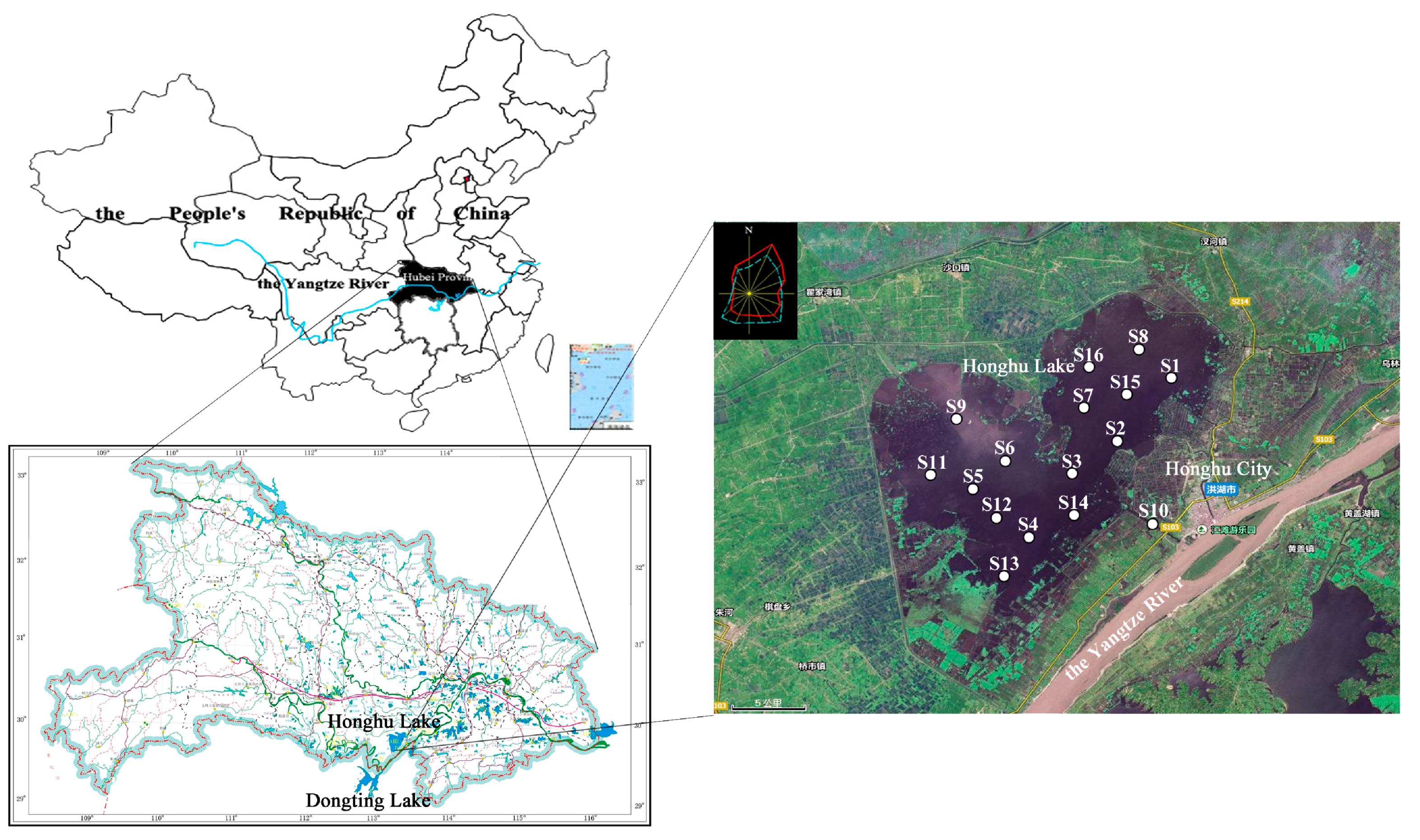
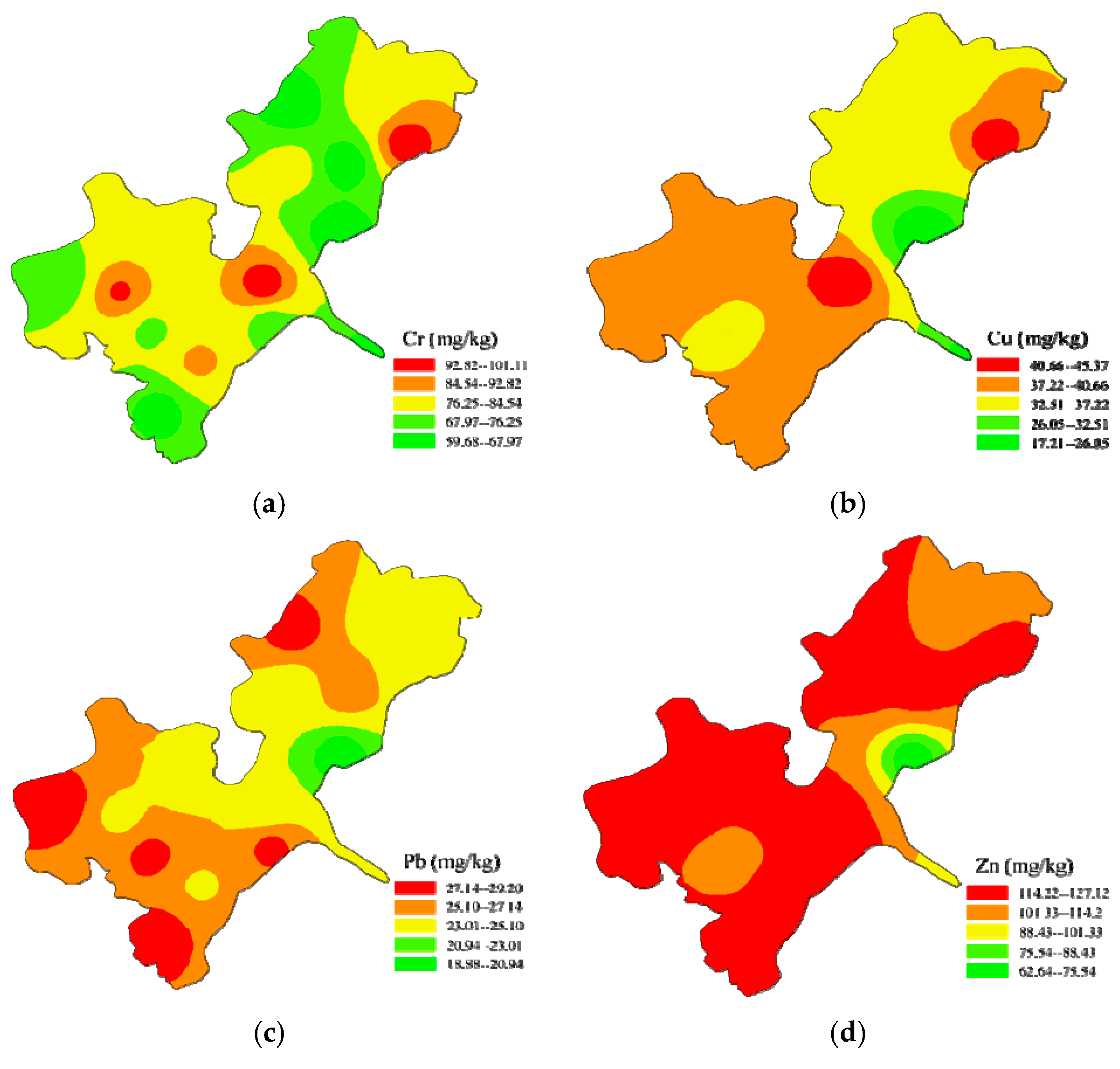
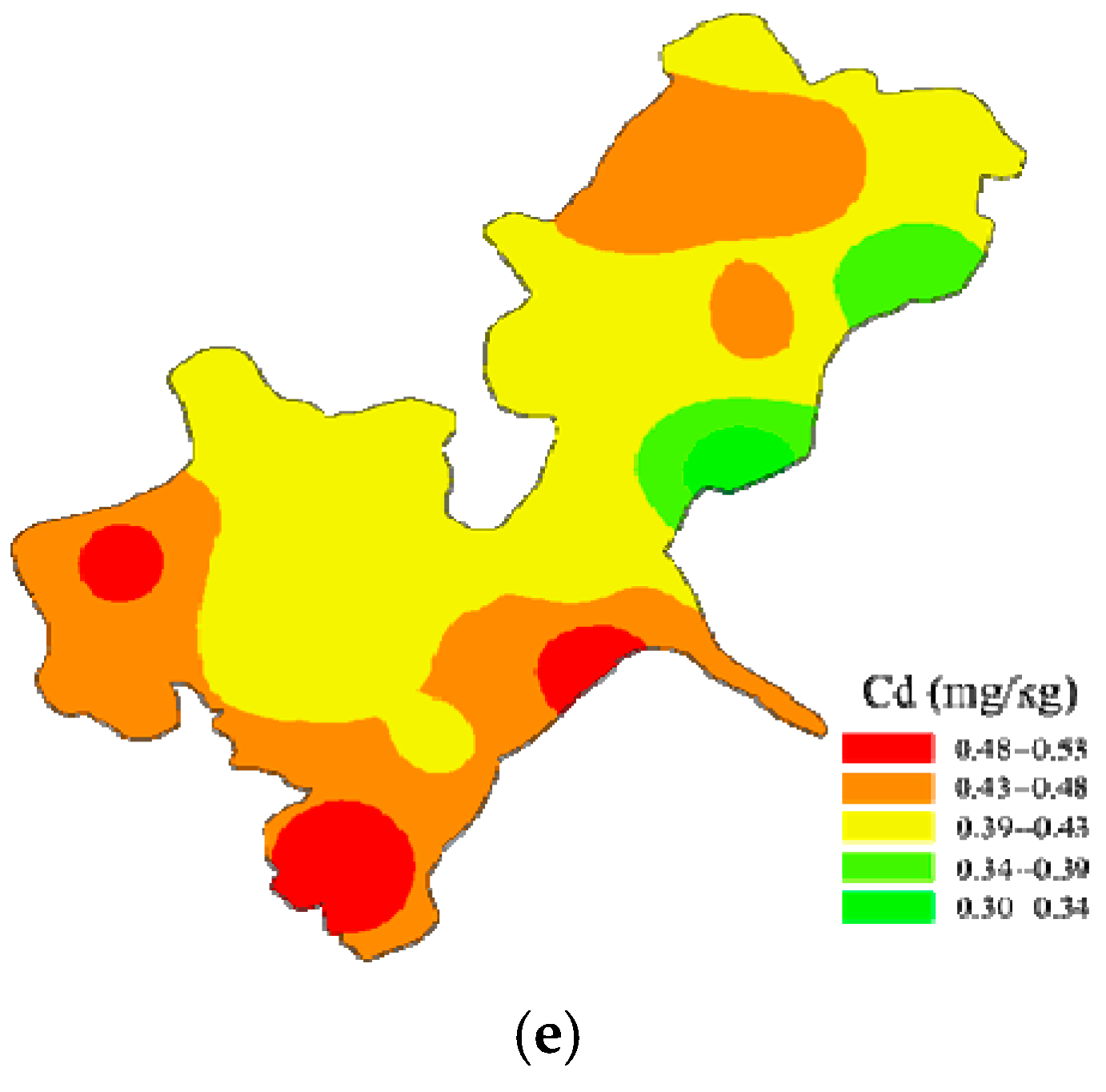
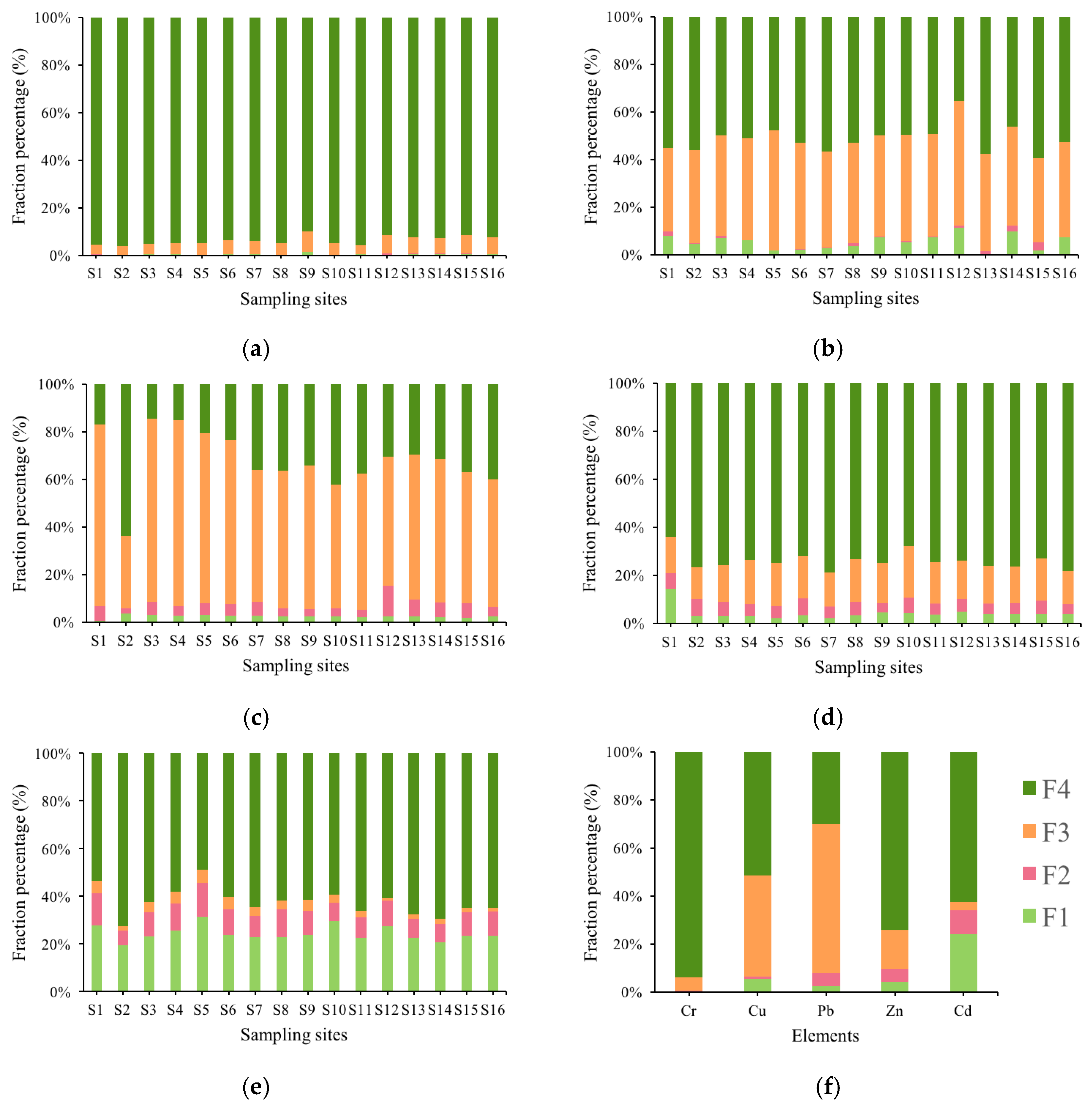
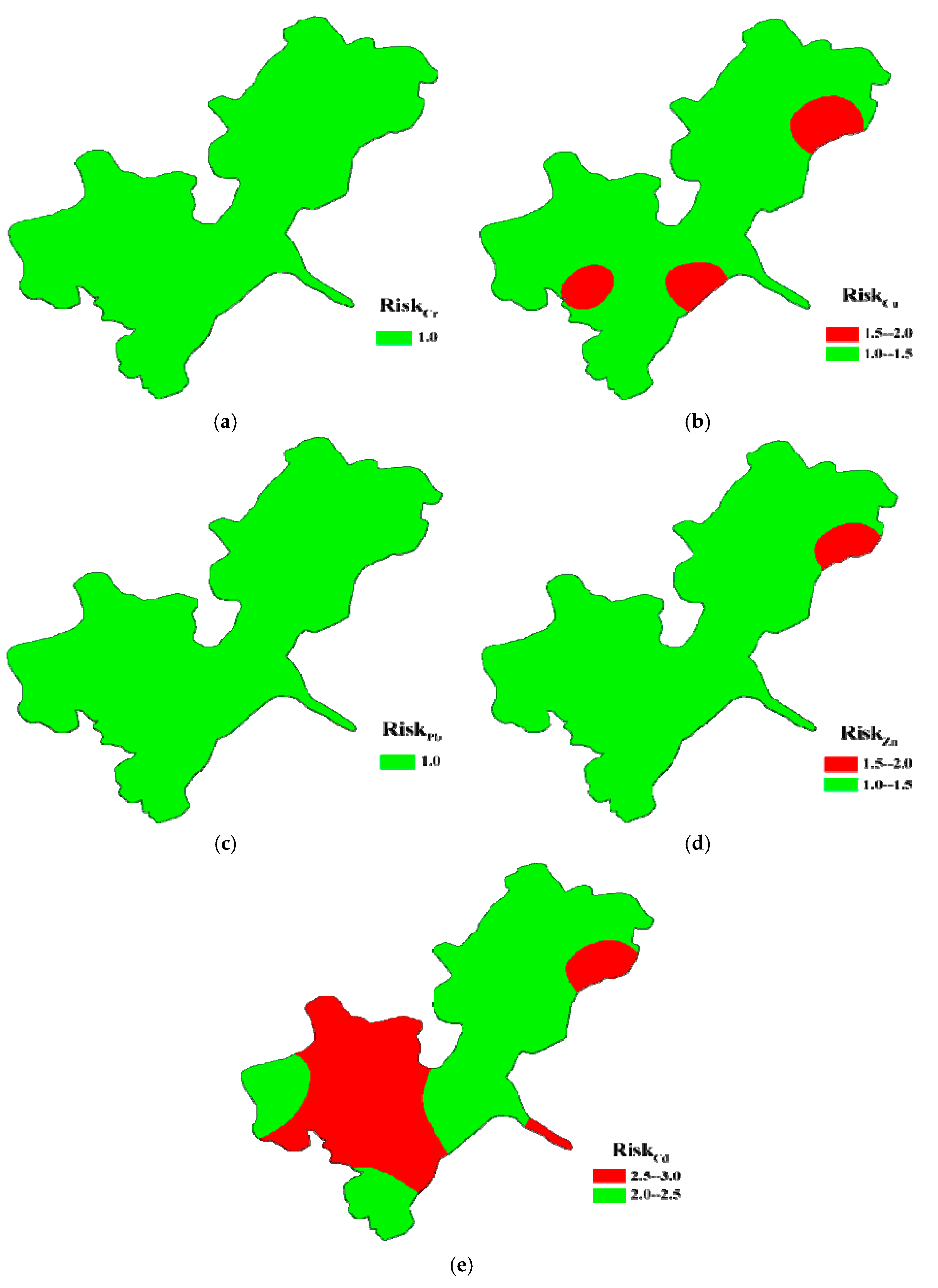

| Level | Value | Extent of Ecological Risk of Single Metal |
|---|---|---|
| I | < 40 | Low potential ecological risk |
| II | 40 ≤ < 80 | Moderate ecological risk |
| III | 80 ≤ < 160 | Considerable ecological risk |
| IV | 160 ≤ < 320 | High ecological risk |
| V | ≥ 320 | Very high ecological risk |
| Level | Value | Risk Degree |
|---|---|---|
| I | < 1 | No biological risk |
| II | 1 ≤ < 10 | Low biological risk |
| III | 10 ≤ < 30 | Moderate biological risk |
| IV | 30 ≤ < 50 | High biological risk |
| V | 50 ≤ ≤ 100 | Very high biological risk |
| Elements | Cr | Cu | Pb | Zn | Cd |
|---|---|---|---|---|---|
| Min | 59.68 | 17.21 | 18.88 | 62.64 | 0.30 |
| Max | 101.11 | 45.37 | 29.20 | 127.12 | 0.53 |
| Mean | 76.36 | 36.41 | 25.29 | 113.79 | 0.43 |
| S.D. 1 | 14.16 | 6.89 | 2.90 | 16.38 | 0.06 |
| Background 2 | 86.0 | 30.7 | 26.7 | 83.6 | 0.172 |
| Grade II 3 | 300 | 100 | 80 | 250 | 0.5 |
| Igeo | −0.75 | −0.34 | −0.66 | −0.14 | 0.77 |
| TEL 4 | 37.3 | 35.7 | 35 | 123.1 | 0.596 |
| PEL 5 | 90 | 196.6 | 91.3 | 314.8 | 3.53 |
© 2018 by the authors. Licensee MDPI, Basel, Switzerland. This article is an open access article distributed under the terms and conditions of the Creative Commons Attribution (CC BY) license (http://creativecommons.org/licenses/by/4.0/).
Share and Cite
Li, F.; Xiao, M.; Zhang, J.; Liu, C.; Qiu, Z.; Cai, Y. Spatial Distribution, Chemical Fraction and Fuzzy Comprehensive Risk Assessment of Heavy Metals in Surface Sediments from the Honghu Lake, China. Int. J. Environ. Res. Public Health 2018, 15, 207. https://doi.org/10.3390/ijerph15020207
Li F, Xiao M, Zhang J, Liu C, Qiu Z, Cai Y. Spatial Distribution, Chemical Fraction and Fuzzy Comprehensive Risk Assessment of Heavy Metals in Surface Sediments from the Honghu Lake, China. International Journal of Environmental Research and Public Health. 2018; 15(2):207. https://doi.org/10.3390/ijerph15020207
Chicago/Turabian StyleLi, Fei, Minsi Xiao, Jingdong Zhang, Chaoyang Liu, Zhenzhen Qiu, and Ying Cai. 2018. "Spatial Distribution, Chemical Fraction and Fuzzy Comprehensive Risk Assessment of Heavy Metals in Surface Sediments from the Honghu Lake, China" International Journal of Environmental Research and Public Health 15, no. 2: 207. https://doi.org/10.3390/ijerph15020207
APA StyleLi, F., Xiao, M., Zhang, J., Liu, C., Qiu, Z., & Cai, Y. (2018). Spatial Distribution, Chemical Fraction and Fuzzy Comprehensive Risk Assessment of Heavy Metals in Surface Sediments from the Honghu Lake, China. International Journal of Environmental Research and Public Health, 15(2), 207. https://doi.org/10.3390/ijerph15020207






